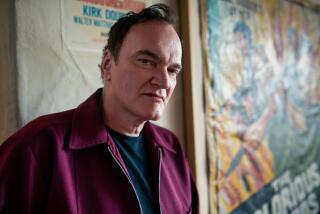Time to Give Tartini a Chance
- Share via
To those of you with a desire to venture beyond “The Four Seasons,” perhaps even beyond Vivaldi, may I recommend Tartini? Among the relative few who have heard of him at all, Giuseppe Tartini (1692-1770) of Padua has the reputation of being just another of the composers who came in Vivaldi’s wake, imitating his leaping arpeggios and sewing-machine rhythms, but without the Venetian master’s presumed transfiguring touch.
Not so. Tartini, while aware of Vivaldi’s music and, like him, one of the foremost violin virtuosi of his time, was his own man, continually challenging himself as performer and composer.
At his best, Tartini was at least as lively an entertainer as Vivaldi, tossing out strong, boldly harmonized tunes seemingly at will; but not as ready as the hyper-prolific Vivaldi to toss them away . Tartini’s melodies tend to be more richly developed, particularly in his achingly chromatic slow movements--which means that any listener whose attention span extends only to Vivaldi’s eight- or nine-minute concertos will have to spare at least an extra five minutes to appreciate Tartini.
It’s difficult to believe that Tartini has ever been better served on recordings than in a program of four of his most powerful concertos from the Accademia Bizantina of Ravenna, a dozen strings with appropriate continuo (variously harpsichord, organ, lute, bassoon) under the direction of Carlo Chiarappa, who is also the superbly equipped violin soloist (Denon 78969).
In the vitality of their performances, these musicians bring to mind the Italian string bands that drove us wild with delight during the Baroque’s second coming, some three decades ago. But the Accademia Bizantina delivers with a degree of polish and stylistic awareness all but unknown in those days. And, as this listener can attest from attending their recent live performances at the Lucerne Festival, the Accademia is not just another recording phenomenon; they are every bit as good in the flesh.
The great orchestral works of Johann Sebastian Bach were so much a part of the Baroque revival of the 1950s and ‘60s, and so over-performed during the subsequent dawning of the “authentic performance” movement a dozen years ago, that record companies no longer regard them as hot properties. So, new versions from respected sources of the six “Brandenburg” Concertos and the four Orchestral Suites, or “Ouvertures” as Bach himself called them, are again something of an event.
The experienced, highly regarded musicians of La Petite Bande, based in Belgium and directed by violinist Sigiswald Kuijken, present the “Brandenburgs” (Deutsche Harmonia Mundi 77308, 2 CDs) while the Suites are in the hands of relative newcomers who are attracting a considerable following in Europe, La Stravaganza Koln (i.e., Cologne), directed by English violinist Andrew Manze (Denon 789 65/6, 2 CDs).
The “Brandenburgs” are faultlessly executed on period instruments. Though only five of the six concertos are included, these are among the most satisfying of the many recorded interpretations. However, in the Second Concerto, Kuijken defies reason by junking the most familiar element of the entire set, the deliciously squealing solo trumpet, in favor of the earthbound horn (valveless, of course.) Claude Maury executes the exacting horn solo impressively. But it’s the wrong sound, on the wrong instrument.
No reservations, however, and no fixing-what-ain’t-broke in La Stravaganza’s Suites. These performances may be informed by cutting-edge Baroque scholarship, but Manze and his colleagues wear their learning so naturally, and play with such vibrancy and skill, that it is likely to communicate even to listeners encountering this music for the hundredth time.
The Suites, in case you’ve forgotten, contain two of the Baroque’s greatest hits: the romping finale of the Second Suite, its flute solo here spun out with exquisite ease and purity of tone (on an 18th-Century wooden instrument) by Masahiro Arita, and the “Air” from the Third Suite, victim of a thousand transcriptions, heard here in its original version and played by the Cologne strings as if they had just discovered it, and fallen in love at first sight.
More to Read
The biggest entertainment stories
Get our big stories about Hollywood, film, television, music, arts, culture and more right in your inbox as soon as they publish.
You may occasionally receive promotional content from the Los Angeles Times.









